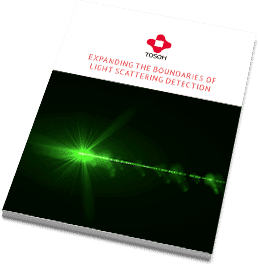Expanding the Boundaries Of Light Scattering Detection

A True Innovation - Comprehensibly Explained
Light scattering detection (LS) is a widely used technique to obtain the “absolute” or true molecular weight of macromolecules such as synthetic polymers, biopolymers, proteins, and antibodies and to characterize these. When coupled with size exclusion chromatography (SEC), molecular weight and size, as well as aggregation or branching can be investigated to provide analytical scientists with a powerful tool for the characterization of polymers, proteins, or antibodies.
Whether new biopharmaceutical products or polymers with tailored properties, the macromolecules’ complexity increases, requiring even more extensive and in-depth characterization. With limited amounts of costly samples available for analysis, new technologies are needed that revolutionize analytical characterization. This is exactly what Tosoh Bioscience has achieved with the completely novel LenS3 MALS detector:
The first significant advancement in light scattering technologies in four decades.
In this white paper, you will learn how to ...
- revolutionize molecular weight and radius of gyration (Rg) measurements
- overcome the limitations of classical light scattering detectors
- optimize detection sensitivity thanks to increased signal intensity and minimal noise
- measure and characterize macromolecules better than ever before
Download white paper now

Expanding the Boundaries Of Light Scattering Detection
A True Innovation - Comprehensibly Explained

